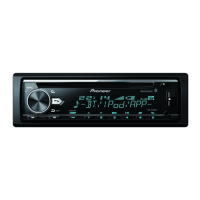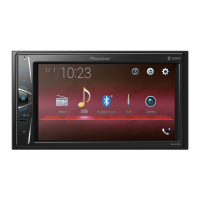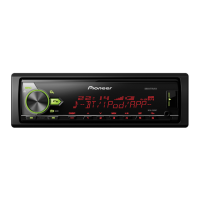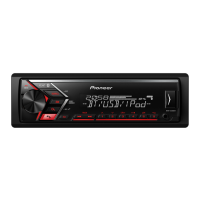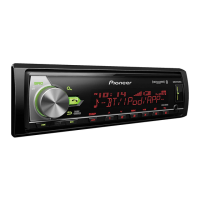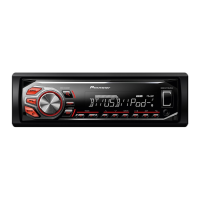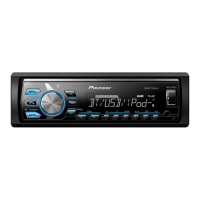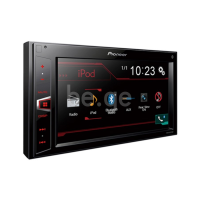
Do you have a question about the Pioneer MVH-AV270BT and is the answer not in the manual?
| Audio system | MOSFET |
|---|---|
| MP3 playback | Yes |
| CD-R playback | - |
| Audio formats supported | AAC, MP3, WAV, WMA |
| Image formats supported | BMP, JPG |
| Video formats supported | DIVX, MPEG1, MPEG2, MPEG4, XVID |
| Supported radio bands | AM, FM |
| Preset stations quantity | 24 |
| DIN size | 2 DIN |
| Product color | Black |
| Disc types supported | No |
| Audio output channels | 4.0 channels |
| Equalizer bands quantity | 5 |
| Maximum power per channel | 50 W |
| Aspect ratio | 16:9 |
| Display diagonal | 6.2 \ |
| Bluetooth profiles | A2DP, HFP, SPP |
| Key illumination color | Red |
Crucial safety warnings and guidelines for product installation and usage to prevent hazards.
Guidelines and warnings to prevent driver distraction and ensure safe operation of the vehicle while using the product.
Information on connecting external displays via V OUT for passenger viewing, with safety considerations.
Instructions to prevent unintended battery drain when using the product, emphasizing engine operation.
Identifies key components and buttons of the device and explains their basic functions for user familiarization.
Step-by-step instructions for safely connecting and disconnecting USB storage devices to the unit.
Guide for initial system setup, including language selection and basic configuration upon first use.
How to access and view the Bluetooth settings menu on the device.
Step-by-step process for pairing your mobile phone or other Bluetooth-enabled devices with the system.
How to enable or disable the automatic connection feature for previously paired Bluetooth devices.
Procedure to remove all previously registered Bluetooth devices from the system's memory.
Guide on accessing the main menu for phone operations, including call history and contacts.
Instructions on how to initiate phone calls using various methods like direct dialing or phone book.
Details on how to register and use speed dial numbers for quick access to frequently called contacts.
Steps for answering or rejecting incoming calls using the hands-free system.
Options to customize various phone-related functions, such as auto-answer and ring tone.
How to configure the system to automatically answer incoming calls without manual intervention.
Instructions for switching to private call mode, allowing direct conversation on the cellular phone.
Important notes and considerations regarding Bluetooth phone connection, call quality, and phone book transfer.
Lists supported iPod models and software versions for optimal performance and compatibility with the unit.
Explains the necessary cables and how to connect iPod devices, detailing available audio and video sources.
Steps to access and begin using the radio tuner functionality.
How to use the BSM feature to automatically save the six strongest radio stations.
Setting the local seek tuning sensitivity to receive only stations with strong signals.
Adjusting the increment for seeking FM radio frequencies, allowing manual or automatic tuning steps.
Options to adjust FM tuner sound for music or talk, prioritizing sound quality or noise reduction.
Enables automatic retuning to a different station broadcasting the same program for better reception.
Automatically searches for stations with the same program identification code (PI) for continuous listening.
Option to restrict radio searches to stations within a specific regional area code.
Steps to begin playback of audio files stored on a USB storage device.
How to browse and select audio files using a list view based on file names.
Allows selection of audio, video, or photo files when a USB device contains mixed media types.
Instructions for viewing video files by browsing through a list of file names on a USB device.
Configures the display time for each image when viewing JPEG or BMP files as a slideshow.
Method to browse and select still image files from a list of names on a USB storage device.
The interface for iPod audio playback, showing track information and controls.
An alternative audio playback screen for iPod, showing different control layouts or information.
Interface for playing video content from a connected iPod, displaying video playback controls.
Detailed guide on how to connect iPod and iPhone devices using specific cables for audio and video playback.
Steps to initiate iPod playback, including connecting the device and selecting the iPod source.
Guide on navigating playlists and selecting specific songs or videos for playback from the iPod.
The primary interface for controlling Bluetooth audio playback, showing track details and playback controls.
An alternative screen for Bluetooth audio playback, potentially offering different control layouts or information.
Steps to activate and begin using the Bluetooth audio player function, including source selection.
Instructions for choosing audio files from a list displayed on the screen, often available for Bluetooth streaming.
Steps to activate and use the AUX input for audio and video sources.
Adjusting video signal settings (e.g., PAL, NTSC) for external video sources connected via AUX.
How to access the main system settings menu for various configurations.
Enabling or disabling the Bluetooth audio source within the system settings for audio playback.
Configuration options for the rear view camera function, including input activation and image display.
Enables or disables safety features that restrict certain functions while the vehicle is in motion.
Option to choose the display language for the system interface and menus.
Controls for turning the system's operational beep sounds on or off.
Calibrates the touch screen sensitivity and response positions for accurate input.
Adjusts display brightness and sets the trigger (auto, manual, time) for dimming the screen.
Accessing the menu for adjusting various audio parameters and sound settings.
Adjusts the front-to-rear (fader) and left-to-right (balance) speaker output levels for optimal sound staging.
Modifies volume levels for individual sources to ensure consistent output when switching between them.
Enhances low and high frequencies at low volumes to compensate for hearing perception.
Increases the bass level to enhance low-frequency audio playback.
Filters out low frequencies from specific audio outputs to prevent distortion or improve clarity.
Provides access to preset equalizer curves and allows customization of audio frequency response.
Allows customization of the user interface's color scheme from a selection of available themes.
Adds frequently used menu items to the Favorites screen for quick access.
Navigates and accesses registered menu items directly from the Favorites screen.
Deletes menu items that were previously added to the Favorites screen.
Instructions for setting the current time and date displayed on the unit, including format options.
Adjusts the aspect ratio for video and image playback to fit different screen modes.
Configures the video signal type (e.g., PAL, NTSC) for the rear view camera input.
Procedures to reset the unit's settings to factory defaults using different methods.
Guide to diagnosing and resolving common operational problems, potential causes, and solutions.
Lists specific error codes displayed by the unit and provides recommended actions for each.
Specific troubleshooting steps and error codes related to USB storage device connectivity and file playback.
Troubleshooting guidance for common error codes encountered with iPod and Bluetooth device connectivity.
Comprehensive details on supported file formats, codecs, and compatibility for various media types.
Charts and notes on compatible audio, video, and image file types, including format specifics.
Specific requirements and limitations for playing various video file formats (e.g., AVI, MP4, MOV) from USB.
Legal information regarding software licensing, copyright, and trademarks associated with the product.
Technical details and compatibility notes for Bluetooth technology and WMA/AAC audio codecs.
Important notes on iPod usage, data backup, and potential issues related to temperature and secure mounting.
Legal disclaimer about copyright infringement when using the system for commercial or public viewing.
Information on licensing and usage rights for MP3 files, clarifying private, non-commercial use.
Guidelines for safely cleaning, maintaining, and protecting the LCD screen from damage and environmental factors.
Key technical specifications including power source, dimensions, weight, and display details.
Technical details for the FM, MW, and LW radio tuners, including frequency ranges and sensitivity.
Technical parameters for USB connectivity, including file system support, speed, and maximum current.





